Quasi-Periodic Pulsations in an M-Class Solar Flare
Abstract
1. Introduction
2. Observation and Measurement
3. Results
4. Discussions and Conclusions
Author Contributions
Funding
Data Availability Statement
Acknowledgments
Conflicts of Interest
| 1 | https://cdaw.gsfc.nasa.gov/CME_list/UNIVERSAL/2014_09/univ2014_09.html (accessed on 5 April 2023). |
| 2 | https://hesperia.gsfc.nasa.gov/sdo/aia/movies/2014/09/23/20140923_2256-2344/ (accessed on 5 April 2023). |
References
- Kupriyanova, E.; Kashapova, L.; Reid, H.; Myagkova, I. Relationship of type III radio bursts with quasi-periodic pulsations in a solar flare. Sol. Phys. 2016, 291, 3427–3438. [Google Scholar] [CrossRef]
- Carley, E.P.; Hayes, L.A.; Murray, S.A.; Morosan, D.E.; Shelley, W.; Vilmer, N.; Gallagher, P.T. Loss-cone instability modulation due to a magnetohydrodynamic sausage mode oscillation in the solar corona. Nat. Commun. 2019, 10, 2276. [Google Scholar] [CrossRef]
- Dolla, L.; Marqué, C.; Seaton, D.; Van Doorsselaere, T.; Dominique, M.; Berghmans, D.; Cabanas, C.; De Groof, A.; Schmutz, W.; Verdini, A.; et al. Time delays in quasi-periodic pulsations observed during the X2. 2 solar flare on 2011 February 15. Astrophys. J. Lett. 2012, 749, L16. [Google Scholar] [CrossRef]
- Dominique, M.; Zhukov, A.; Dolla, L.; Inglis, A.; Lapenta, G. Detection of quasi-periodic pulsations in solar EUV time series. Sol. Phys. 2018, 293, 61. [Google Scholar] [CrossRef]
- Milligan, R.O.; Fleck, B.; Ireland, J.; Fletcher, L.; Dennis, B.R. Detection of three-minute oscillations in full-disk Lyα emission during a solar flare. Astrophys. J. Lett. 2017, 848, L8. [Google Scholar] [CrossRef]
- Lu, L.; Li, D.; Ning, Z.; Feng, L.; Gan, W. Quasi-periodic pulsations detected in Ly α and nonthermal emissions during solar flares. Sol. Phys. 2021, 296, 130. [Google Scholar] [CrossRef]
- Nakariakov, V.; Foullon, C.; Myagkova, I.; Inglis, A. Quasi-periodic pulsations in the gamma-ray emission of a solar flare. Astrophys. J. Lett. 2009, 708, L47. [Google Scholar] [CrossRef]
- Li, D.; Kolotkov, D.; Nakariakov, V.; Lu, L.; Ning, Z. Quasi-periodic pulsations of gamma-ray emissions from a solar flare on 2017 September 6. Astrophys. J. 2020, 888, 53. [Google Scholar] [CrossRef]
- Li, T.; Zhang, J. Quasi-periodic slipping magnetic reconnection during an X-class solar flare observed by the solar dynamics observatory and interface region imaging spectrograph. Astrophys. J. Lett. 2015, 804, L8. [Google Scholar] [CrossRef]
- Tian, H.; Young, P.R.; Reeves, K.K.; Wang, T.; Antolin, P.; Chen, B.; He, J. Global sausage oscillation of solar flare loops detected by the interface region imaging spectrograph. Astrophys. J. Lett. 2016, 823, L16. [Google Scholar] [CrossRef]
- Li, D.; Ning, Z.; Huang, Y.; Chen, N.H.; Zhang, Q.; Su, Y.; Su, W. Doppler shift oscillations from a hot line observed by IRIS. Astrophys. J. 2017, 849, 113. [Google Scholar] [CrossRef]
- Brosius, J.W.; Daw, A.N. Quasi-periodic fluctuations and chromospheric evaporation in a solar flare ribbon observed by IRIS. Astrophys. J. 2015, 810, 45. [Google Scholar] [CrossRef]
- Ofman, L.; Wang, T. Hot coronal loop oscillations observed by SUMER: Slow magnetosonic wave damping by thermal conduction. Astrophys. J. 2002, 580, L85. [Google Scholar] [CrossRef]
- Wang, T. Standing slow-mode waves in hot coronal loops: Observations, modeling, and coronal seismology. Space Sci. Rev. 2011, 158, 397–419. [Google Scholar] [CrossRef]
- Tan, B.; Zhang, Y.; Tan, C.; Liu, Y. Microwave quasi-periodic pulsations in multi-timescales associated with a solar flare/CME event. Astrophys. J. 2010, 723, 25. [Google Scholar] [CrossRef]
- Aschwanden, M. Theory of radio pulsations in coronal loops. Sol. Phys. 1987, 111, 113–136. [Google Scholar] [CrossRef]
- Aschwanden, M.J.; Benz, A.O.; Dennis, B.R.; Kundu, M.R. Pulsed acceleration in solar flares. In International Astronomical Union Colloquium; Cambridge University Press: Cambridge, UK, 1994; Volume 142, pp. 631–638. [Google Scholar]
- Fleishman, G.; Fu, Q.; Huang, G.L.; Melnikov, V.; Wang, M. Discovery of unusual large group delay in microwave millisecond oscillating events. Astron. Astrophys. 2002, 385, 671–685. [Google Scholar] [CrossRef]
- Ning, Z.; Ding, M.; Wu, H.; Xu, F.; Meng, X. Microwave type III bursts and pulsation groups. Astron. Astrophys. 2005, 437, 691–697. [Google Scholar] [CrossRef]
- Ning, Z.; Wu, H.; Xu, F.; Meng, X. Frequency distributions of microwave pulses for the 18 march 2003 solar flare. Sol. Phys. 2007, 242, 101–109. [Google Scholar] [CrossRef]
- Dulk, G.A. Radio emission from the sun and stars. Annu. Rev. Astron. Astrophys. 1985, 23, 169–224. [Google Scholar] [CrossRef]
- Masuda, S.; Kosugi, T.; Hara, H.; Tsuneta, S.; Ogawara, Y. A loop-top hard X-ray source in a compact solar flare as evidence for magnetic reconnection. Nature 1994, 371, 495–497. [Google Scholar] [CrossRef]
- Druett, M.K.; Zharkova, V. Non-thermal hydrogen Lyman line and continuum emission in solar flares generated by electron beams. Astron. Astrophys. 2019, 623, A20. [Google Scholar] [CrossRef]
- Chowdhury, P.; Srivastava, A.; Dwivedi, B.; Sych, R.; Moon, Y.J. Study of multi-periodic coronal pulsations during an X-class solar flare. Adv. Space Res. 2015, 56, 2769–2778. [Google Scholar] [CrossRef]
- Kupriyanova, E.G.; Kashapova, L.K.; Van Doorsselaere, T.; Chowdhury, P.; Srivastava, A.K.; Moon, Y.J. Quasi-periodic pulsations in a solar flare with an unusual phase shift. Mon. Not. R. Astron. Soc. 2019, 483, 5499–5507. [Google Scholar] [CrossRef]
- Tian, H.; Young, P.R.; Reeves, K.K.; Chen, B.; Liu, W.; McKillop, S. Temporal evolution of chromospheric evaporation: Case studies of the M1. 1 flare on 2014 September 6 and X1. 6 flare on 2014 September 10. Astrophys. J. 2015, 811, 139. [Google Scholar] [CrossRef]
- Kumar, P.; Nakariakov, V.M.; Cho, K.S. Observation of a short period quasi-periodic pulsation in solar X-ray, microwave, and EUV emissions. Astrophys. J. 2017, 836, 121. [Google Scholar] [CrossRef]
- Nakariakov, V.; Anfinogentov, S.; Storozhenko, A.; Kurochkin, E.; Bogod, V.; Sharykin, I.; Kaltman, T. Quasi-periodic pulsations in a solar microflare. Astrophys. J. 2018, 859, 154. [Google Scholar] [CrossRef]
- Mészárosová, H.; Karlickỳ, M.; Rybák, J.; Fárník, F.; Jiřička, K. Long period variations of dm-radio and X-ray fluxes in three X-class flares. Astron. Astrophys. 2006, 460, 865–874. [Google Scholar] [CrossRef]
- Kolotkov, D.Y.; Pugh, C.E.; Broomhall, A.M.; Nakariakov, V.M. Quasi-periodic pulsations in the most powerful solar flare of cycle 24. Astrophys. J. Lett. 2018, 858, L3. [Google Scholar] [CrossRef]
- Maehara, H.; Shibayama, T.; Notsu, Y.; Notsu, S.; Honda, S.; Nogami, D.; Shibata, K. Statistical properties of superflares on solar-type stars based on 1-min cadence data. Earth Planets Space 2015, 67, 59. [Google Scholar] [CrossRef]
- Simões, P.J.; Hudson, H.S.; Fletcher, L. Soft X-ray pulsations in solar flares. Sol. Phys. 2015, 290, 3625–3639. [Google Scholar] [CrossRef]
- Inglis, A.; Ireland, J.; Dennis, B.; Hayes, L.; Gallagher, P. A large-scale search for evidence of quasi-periodic pulsations in solar flares. Astrophys. J. 2016, 833, 284. [Google Scholar] [CrossRef]
- Hayes, L.A.; Inglis, A.R.; Christe, S.; Dennis, B.; Gallagher, P.T. Statistical study of GOES X-ray quasi-periodic pulsations in solar flares. Astrophys. J. 2020, 895, 50. [Google Scholar] [CrossRef]
- Pugh, C.; Broomhall, A.M.; Nakariakov, V. Scaling laws of quasi-periodic pulsations in solar flares. Astron. Astrophys. 2019, 624, A65. [Google Scholar] [CrossRef]
- Kliem, B.; Karlicky, M.; Benz, A.O. Solar flare radio pulsations as a signature of dynamic magnetic reconnection. arXiv 2000, arXiv:astro-ph/0006324v1. [Google Scholar]
- Kumar, P.; Cho, K.S. Simultaneous EUV and radio observations of bidirectional plasmoids ejection during magnetic reconnection. Astron. Astrophys. 2013, 557, A115. [Google Scholar] [CrossRef]
- Takasao, S.; Matsumoto, T.; Nakamura, N.; Shibata, K. Magnetohydrodynamic shocks in and above post-flare loops: Two-dimensional simulation and a simplified model. Astrophys. J. 2015, 805, 135. [Google Scholar] [CrossRef]
- Tajima, T.; Sakai, J.; Nakajima, H.; Kosugi, T.; Brunel, F.; Kundu, M. Current loop coalescence model of solar flares. Astrophys. J. 1987, 321, 1031–1048. [Google Scholar] [CrossRef]
- Kumar, P.; Srivastava, A.; Somov, B.; Manoharan, P.; Erdélyi, R.; Uddin, W. Evidence of solar flare triggering due to Loop–Loop interaction caused by footpoint shear motion. Astrophys. J. 2010, 723, 1651. [Google Scholar] [CrossRef]
- Ning, Z.; Innes, D.; Solanki, S. Line profile characteristics of solar explosive event bursts. Astron. Astrophys. 2004, 419, 1141–1148. [Google Scholar] [CrossRef]
- Lin, R.P.; Dennis, B.R.; Hurford, G.J.; Smith, D.M.; Zehnder, A.; Harvey, P.R.; Curtis, D.W.; Pankow, D.; Turin, P.; Bester, M.; et al. The Reuven Ramaty high-energy solar spectroscopic imager (RHESSI). In The Reuven Ramaty High-Energy Solar Spectroscopic Imager (RHESSI) Mission Description and Early Results; Springer: Dordrecht, The Netherlands, 2003; pp. 3–32. [Google Scholar]
- Lemen, J.R.; Title, A.M.; Akin, D.J.; Boerner, P.F.; Chou, C.; Drake, J.F.; Duncan, D.W.; Edwards, C.G.; Friedlaender, F.M.; Heyman, G.F.; et al. The atmospheric imaging assembly (AIA) on the solar dynamics observatory (SDO). Sol. Phys. 2012, 275, 17–40. [Google Scholar] [CrossRef]
- Pesnell, W.D.; Thompson, B.J.; Chamberlin, P. The Solar Dynamics Observatory (SDO); Springer: Berlin/Heidelberg, Germany, 2012. [Google Scholar]
- Ning, Z. Imaging observations of X-ray quasi-periodic oscillations at 3–6 keV in the 26 December 2002 solar flare. Sol. Phys. 2014, 289, 1239–1256. [Google Scholar] [CrossRef]
- Mishra, S.K.; Sangal, K.; Kayshap, P.; Jelinek, P.; Srivastava, A.; Rajaguru, S. Origin of Quasi-Periodic Pulsation at the Base of Kink Unstable Jet. arXiv 2023, arXiv:2301.01534. [Google Scholar] [CrossRef]
- Li, D.; Shi, F.; Zhao, H.; Xiong, S.; Song, L.; Peng, W.; Li, X.; Chen, W.; Ning, Z. Flare quasi-periodic pulsation associated with recurrent jets. arXiv 2022, arXiv:2209.10952. [Google Scholar] [CrossRef]
- Yang, S.; Xiang, Y. Oscillation of newly formed loops after magnetic reconnection in the solar chromosphere. Astrophys. J. Lett. 2016, 819, L24. [Google Scholar] [CrossRef]
- Hong, Z.; Li, D.; Zhang, M.; Tan, C.; Ma, S.; Ji, H. Multi-Wavelength Observations of Quasi-Periodic Pulsations in a Solar Flare. Sol. Phys. 2021, 296, 171. [Google Scholar] [CrossRef]
- Srivastava, A.; Zaqarashvili, T.; Uddin, W.; Dwivedi, B.; Kumar, P. Observation of multiple sausage oscillations in cool post-flare loop. Mon. Not. R. Astron. Soc. 2008, 388, 1899–1903. [Google Scholar] [CrossRef]
- Li, D.; Feng, S.; Su, W.; Huang, Y. Preflare very long-periodic pulsations observed in Hα emission before the onset of a solar flare. Astron. Astrophys. 2020, 639, L5. [Google Scholar] [CrossRef]
- Nakariakov, V.; Pilipenko, V.; Heilig, B.; Jelínek, P.; Karlickỳ, M.; Klimushkin, D.; Kolotkov, D.; Lee, D.H.; Nisticò, G.; Van Doorsselaere, T.; et al. Magnetohydrodynamic oscillations in the solar corona and Earth’s magnetosphere: Towards consolidated understanding. Space Sci. Rev. 2016, 200, 75–203. [Google Scholar] [CrossRef]
- Fleishman, G.D.; Bastian, T.; Gary, D.E. Broadband quasi-periodic radio and X-ray pulsations in a solar flare. Astrophys. J. 2008, 684, 1433. [Google Scholar] [CrossRef]
- Inglis, A.; Nakariakov, V.; Melnikov, V. Multi-wavelength spatially resolved analysis of quasi-periodic pulsations in a solar flare. Astron. Astrophys. 2008, 487, 1147–1153. [Google Scholar] [CrossRef]
- Asai, A.; Shimojo, M.; Isobe, H.; Morimoto, T.; Yokoyama, T.; Shibasaki, K.; Nakajima, H. Periodic acceleration of electrons in the 1998 November 10 solar flare. Astrophys. J. 2001, 562, L103. [Google Scholar] [CrossRef]
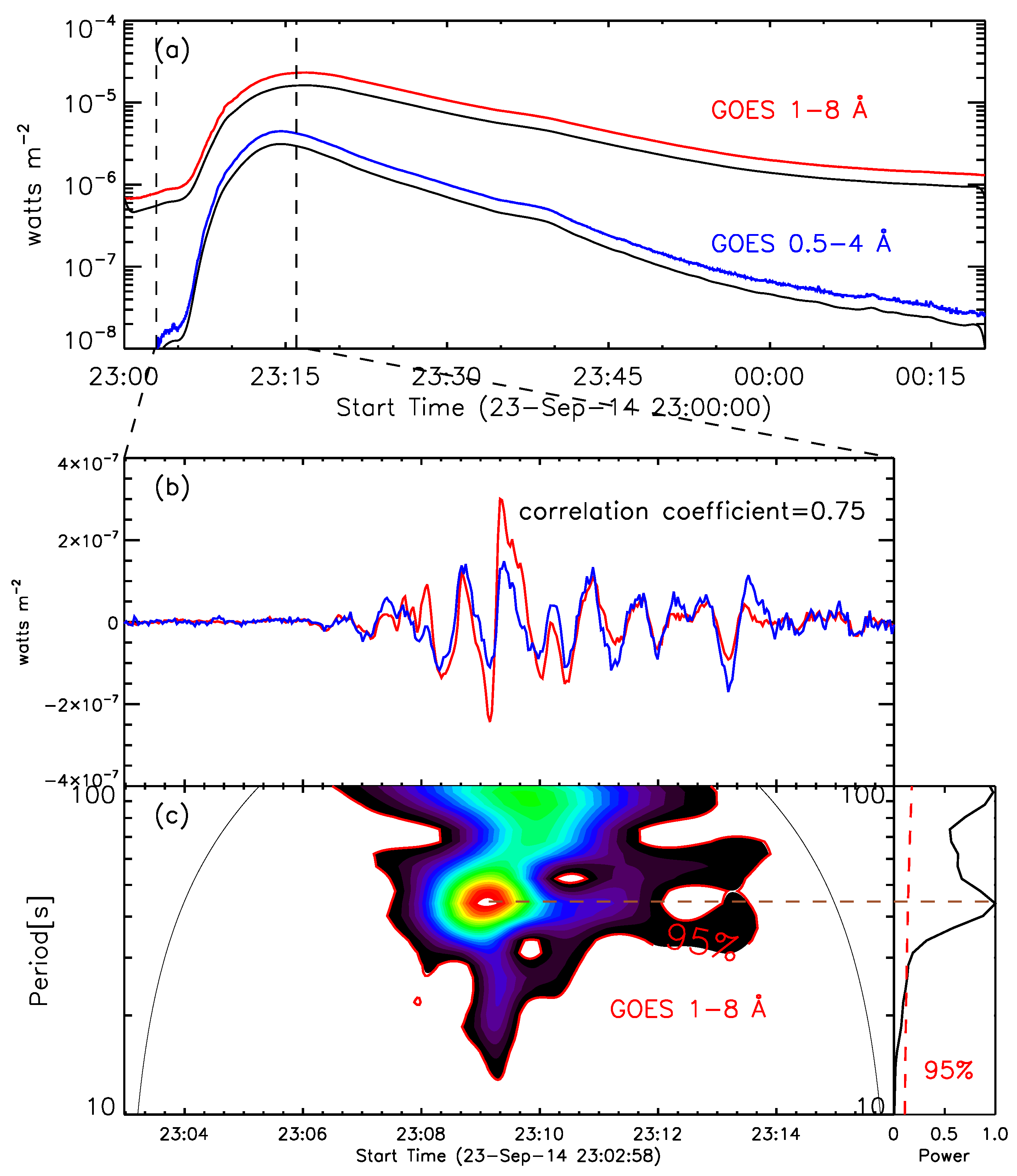
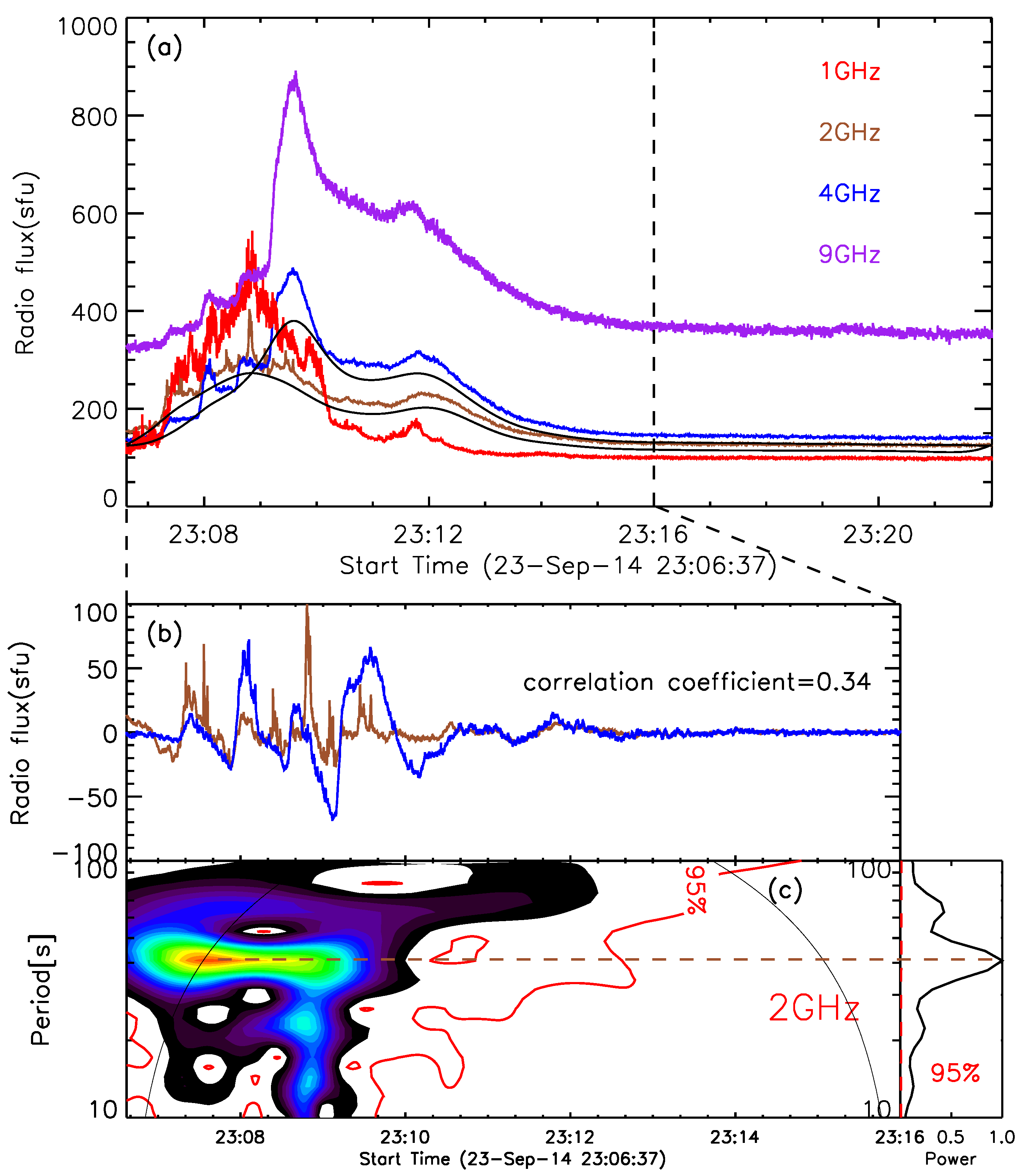
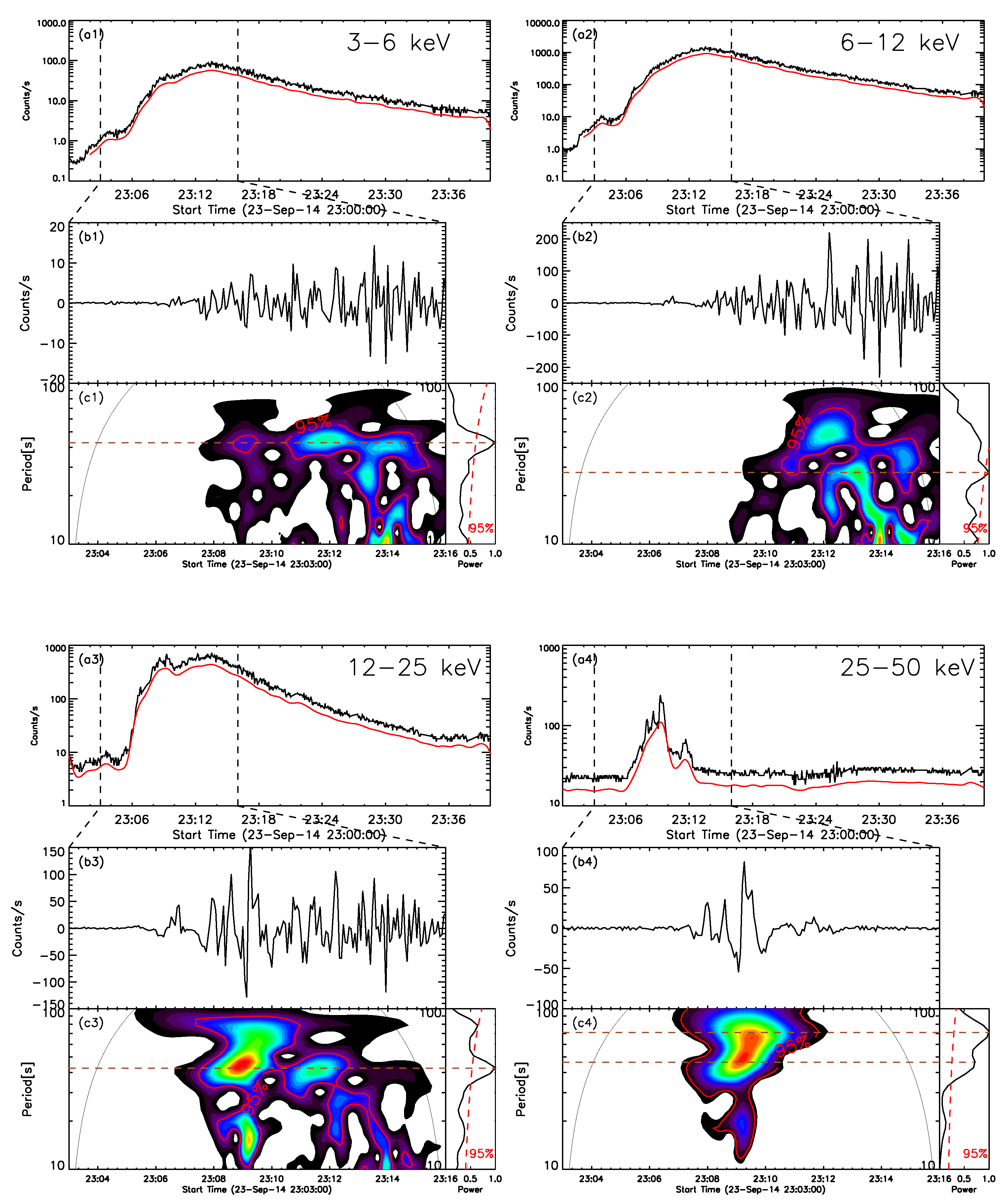
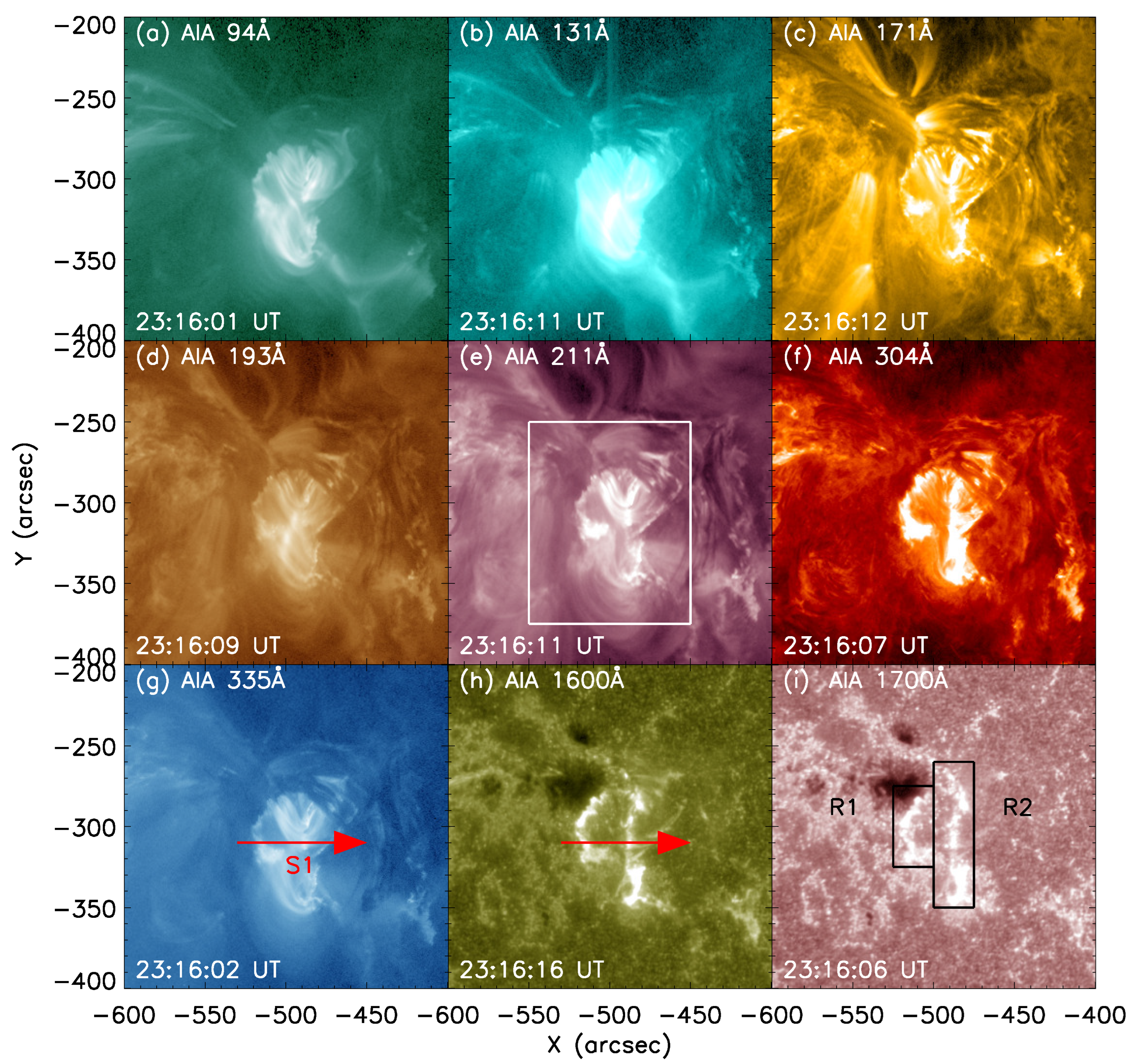
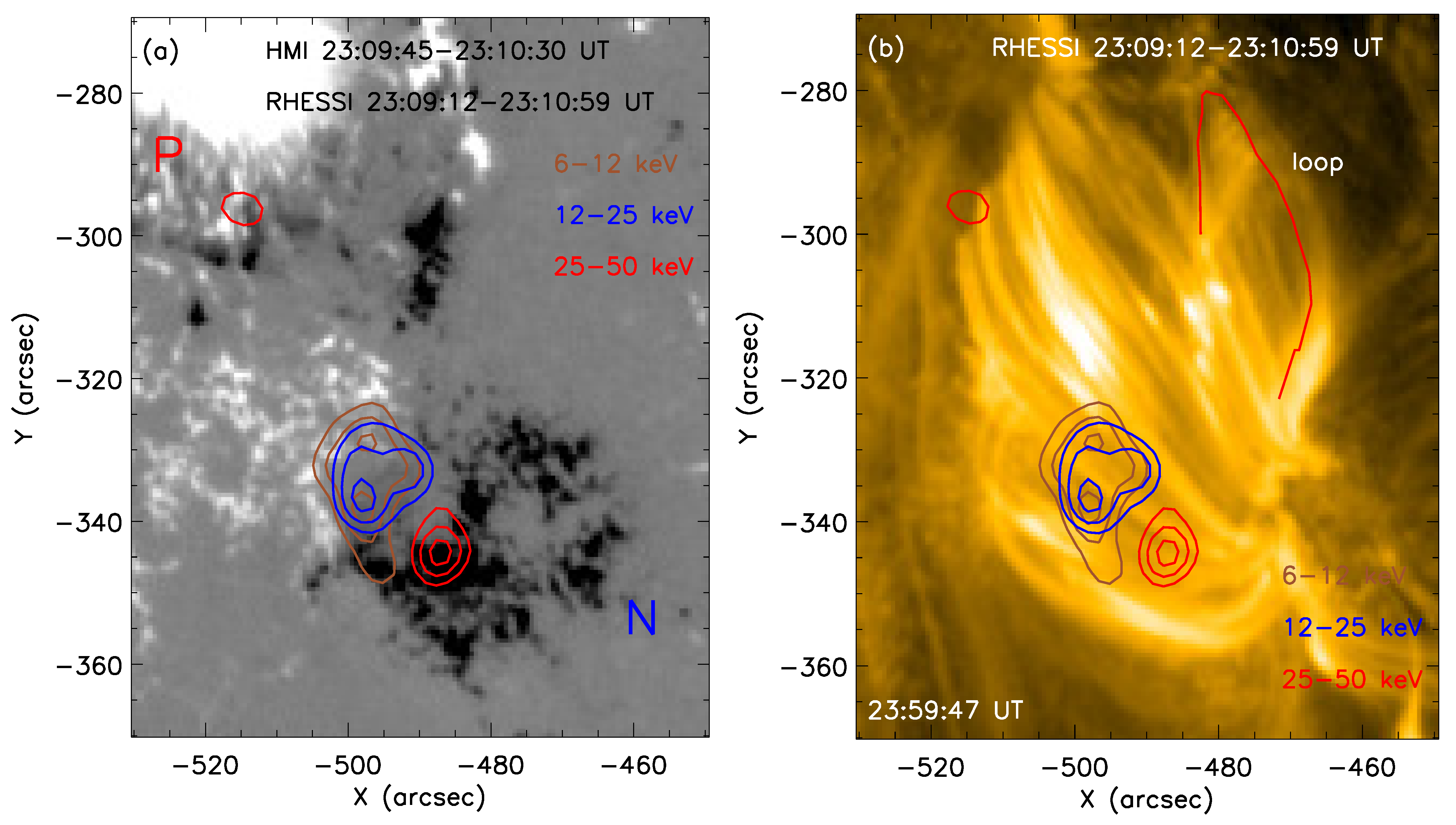
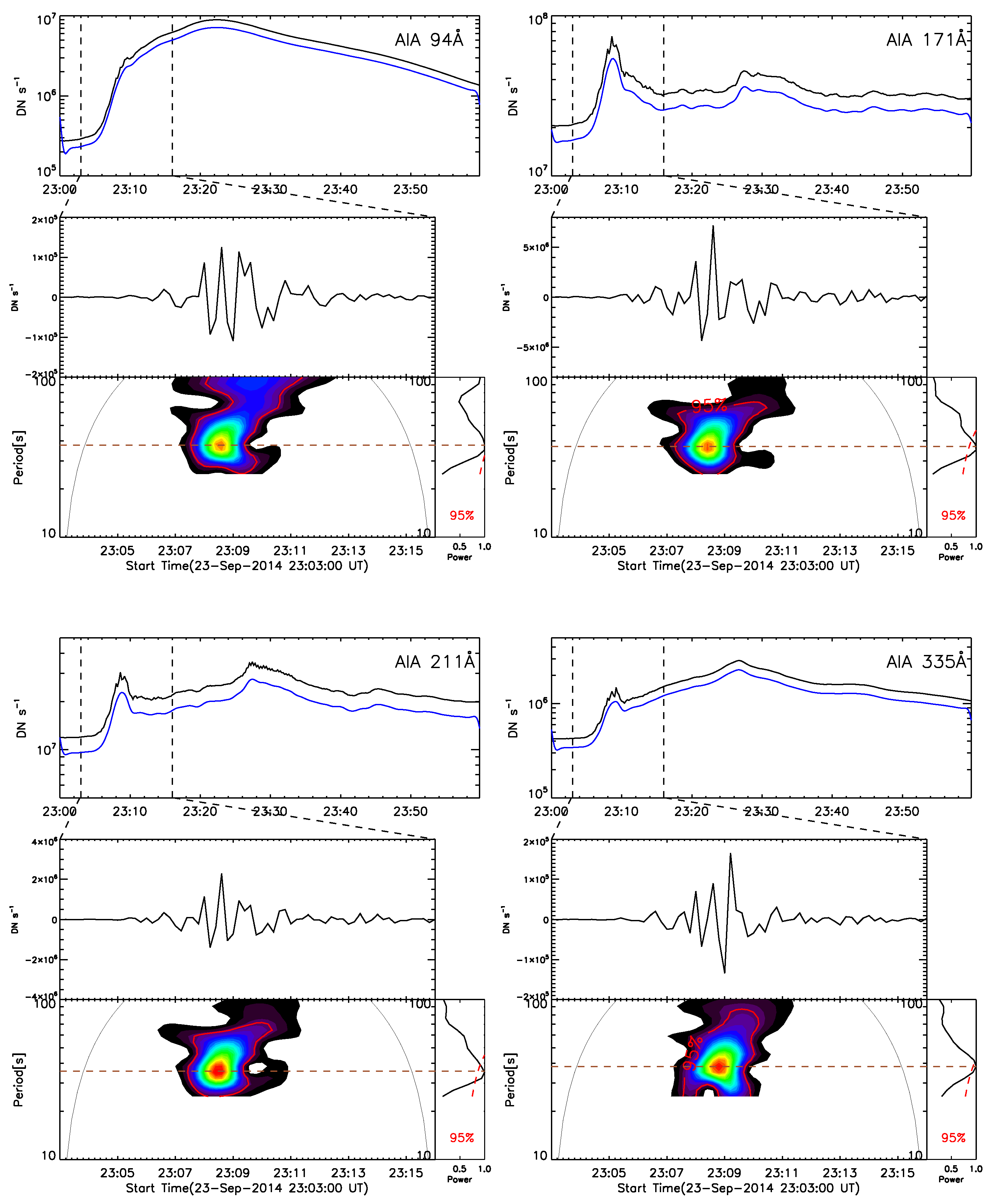
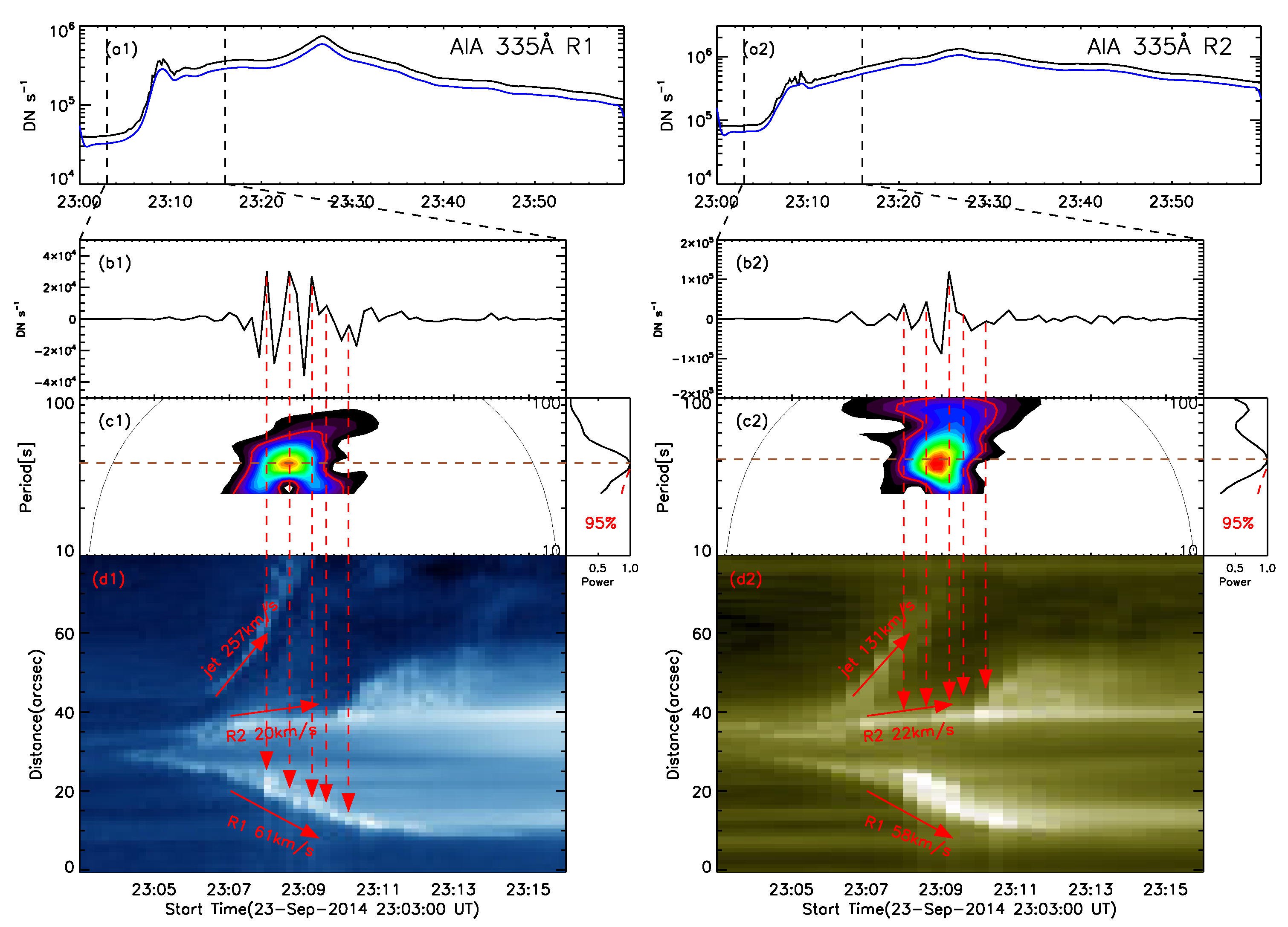
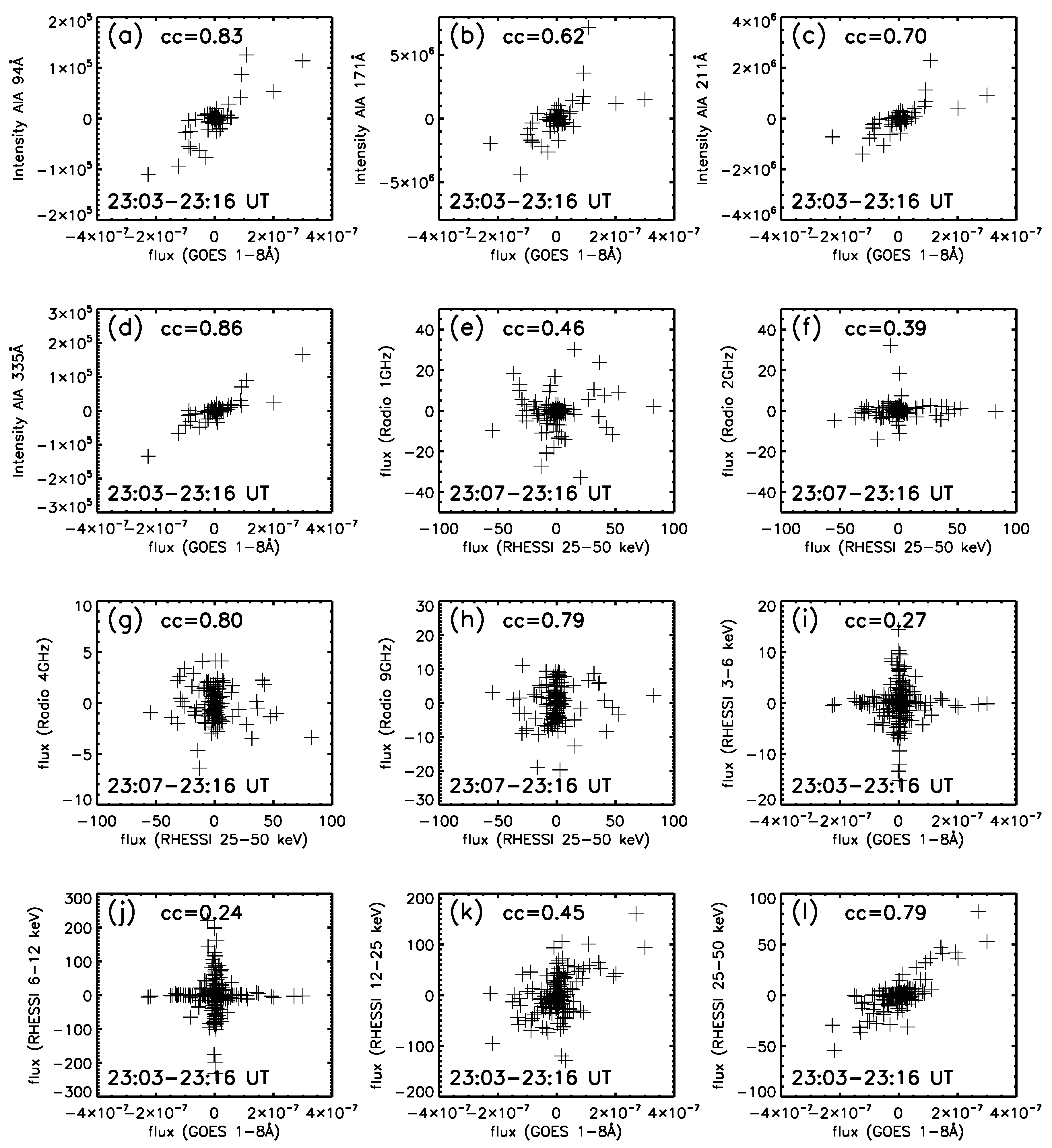
Disclaimer/Publisher’s Note: The statements, opinions and data contained in all publications are solely those of the individual author(s) and contributor(s) and not of MDPI and/or the editor(s). MDPI and/or the editor(s) disclaim responsibility for any injury to people or property resulting from any ideas, methods, instructions or products referred to in the content. |
© 2023 by the authors. Licensee MDPI, Basel, Switzerland. This article is an open access article distributed under the terms and conditions of the Creative Commons Attribution (CC BY) license (https://creativecommons.org/licenses/by/4.0/).
Share and Cite
Xu, J.; Ning, Z.; Li, D.; Shi, F. Quasi-Periodic Pulsations in an M-Class Solar Flare. Universe 2023, 9, 215. https://doi.org/10.3390/universe9050215
Xu J, Ning Z, Li D, Shi F. Quasi-Periodic Pulsations in an M-Class Solar Flare. Universe. 2023; 9(5):215. https://doi.org/10.3390/universe9050215
Chicago/Turabian StyleXu, Jun, Zongjun Ning, Dong Li, and Fanpeng Shi. 2023. "Quasi-Periodic Pulsations in an M-Class Solar Flare" Universe 9, no. 5: 215. https://doi.org/10.3390/universe9050215
APA StyleXu, J., Ning, Z., Li, D., & Shi, F. (2023). Quasi-Periodic Pulsations in an M-Class Solar Flare. Universe, 9(5), 215. https://doi.org/10.3390/universe9050215






